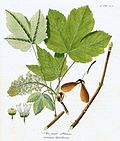Acer pseudoplatanus
Acer pseudoplatanus
Acer pseudoplatanus, commonly known as the sycamore maple, is a species of maple native to Central Europe and Western Asia. It is a large deciduous tree that can grow up to 35 meters tall, with a broad, domed crown. The tree is widely planted as an ornamental and shade tree in urban areas and is valued for its hardiness and adaptability.
Description
Acer pseudoplatanus is characterized by its large, palmate leaves, which are typically 10–25 cm long and broad, with five lobes. The leaves are dark green on the upper surface and paler underneath. In autumn, the leaves turn a striking yellow or brown before falling.
The bark of the sycamore maple is smooth and grey when young, becoming rough and scaly with age. The tree produces small, greenish-yellow flowers in spring, which are arranged in pendulous racemes. The fruit is a double samara, with two winged seeds that are dispersed by the wind.
Distribution and Habitat
Acer pseudoplatanus is native to Europe and Western Asia, where it grows in a variety of habitats, including woodlands, riverbanks, and rocky slopes. It is tolerant of a wide range of soil types and conditions, including urban environments, where it is often planted as a street tree.
Ecological Importance
The sycamore maple provides habitat and food for a variety of wildlife. Its leaves are a food source for the larvae of several species of Lepidoptera, including the sycamore moth. The tree's flowers provide nectar for bees and other pollinators, while its seeds are eaten by birds and small mammals.
Uses
Acer pseudoplatanus is widely used in landscaping and forestry. Its wood is valued for its strength and workability, making it suitable for furniture, flooring, and musical instruments. The tree is also planted for its aesthetic appeal and ability to provide shade in urban areas.
Pests and Diseases
The sycamore maple is susceptible to several pests and diseases, including the sycamore aphid and tar spot disease, caused by the fungus Rhytisma acerinum. These can affect the tree's health and appearance but are rarely fatal.
Gallery
Related pages
Transform your life with W8MD's budget GLP-1 injections from $125.
W8MD offers a medical weight loss program to lose weight in Philadelphia. Our physician-supervised medical weight loss provides:
- Most insurances accepted or discounted self-pay rates. We will obtain insurance prior authorizations if needed.
- Generic GLP1 weight loss injections from $125 for the starting dose.
- Also offer prescription weight loss medications including Phentermine, Qsymia, Diethylpropion, Contrave etc.
NYC weight loss doctor appointments
Start your NYC weight loss journey today at our NYC medical weight loss and Philadelphia medical weight loss clinics.
- Call 718-946-5500 to lose weight in NYC or for medical weight loss in Philadelphia 215-676-2334.
- Tags:NYC medical weight loss, Philadelphia lose weight Zepbound NYC, Budget GLP1 weight loss injections, Wegovy Philadelphia, Wegovy NYC, Philadelphia medical weight loss, Brookly weight loss and Wegovy NYC
|
WikiMD's Wellness Encyclopedia |
| Let Food Be Thy Medicine Medicine Thy Food - Hippocrates |
Medical Disclaimer: WikiMD is not a substitute for professional medical advice. The information on WikiMD is provided as an information resource only, may be incorrect, outdated or misleading, and is not to be used or relied on for any diagnostic or treatment purposes. Please consult your health care provider before making any healthcare decisions or for guidance about a specific medical condition. WikiMD expressly disclaims responsibility, and shall have no liability, for any damages, loss, injury, or liability whatsoever suffered as a result of your reliance on the information contained in this site. By visiting this site you agree to the foregoing terms and conditions, which may from time to time be changed or supplemented by WikiMD. If you do not agree to the foregoing terms and conditions, you should not enter or use this site. See full disclaimer.
Credits:Most images are courtesy of Wikimedia commons, and templates, categories Wikipedia, licensed under CC BY SA or similar.
Contributors: Prab R. Tumpati, MD










